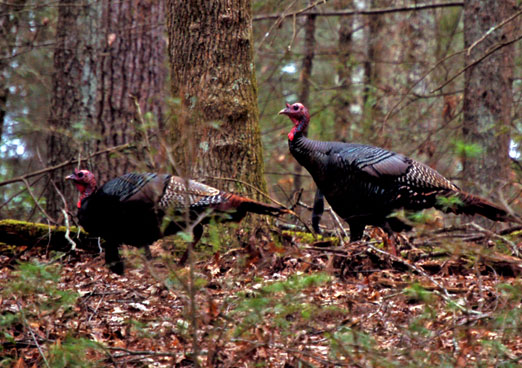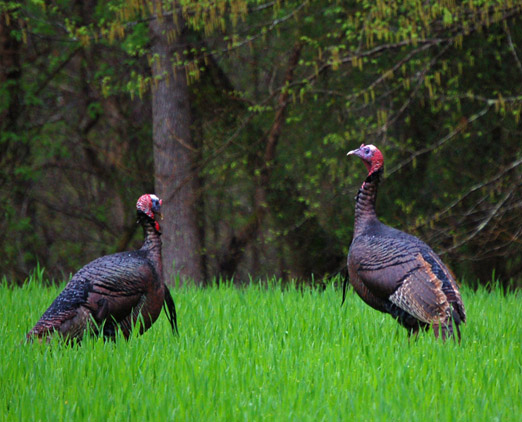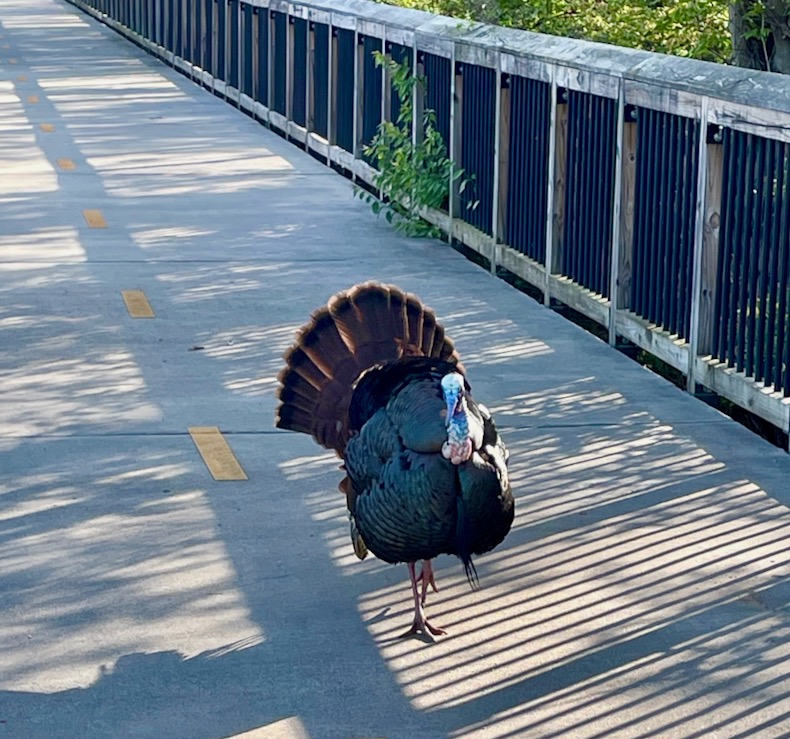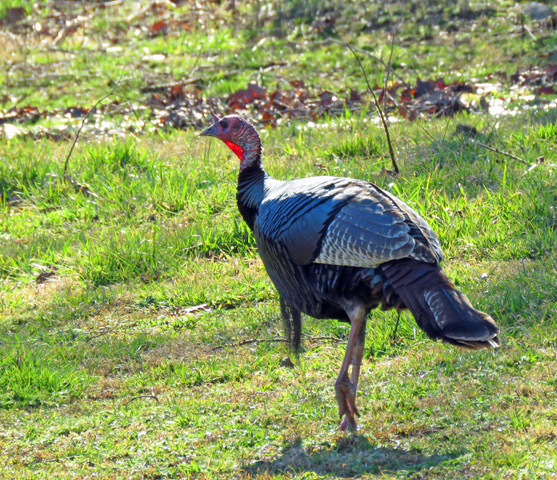By Alonso Abugattas –
WASHINGTON, D.C. — The wild turkey has made an incredible comeback. Not that long ago, wild turkeys were all but wiped out by a combination of overhunting and habitat loss.
By the early 1900s, none remained in the District of Columbia and very few remained in the woods of Maryland, Virginia, New York, Delaware or Pennsylvania, to say nothing of the other 34 U.S. states that the birds were known to inhabit. They are thought to have vanished entirely in as many as 18 of those states.
Then, thanks to great restoration efforts by game commissions and hunting groups, wild turkeys were reintroduced into their former native range.
Early efforts to replenish populations with birds raised in captivity were largely unsuccessful. But “trap and transfer” programs begun in the 1940s — capturing wild birds and strategically relocating them — began to have the desired effect.
Turkeys are becoming increasingly more common. Plus, the land need not be that wild for them to survive. They’re found in not only suburban areas, but in major cities such as Washington, D.C., and New York.
The wild turkey (genus Meliagris) is a “New World” bird, with two species found in North America: the eastern wild turkey (M. gallopavo), found in the wild in 38 U.S. states and several Canadian provinces, and the ocellated turkey (M. ocellata), found in central America. There are six subspecies of the eastern wild turkey, and interbreeding occurs.
According to the National Wild Turkey Federation, the one you’re most likely to see east of the Mississippi River is M. gallopavo sylvestris. Its subspecific name (sylvestris) refers to the bird’s preferred environs: forests.
Wild turkeys are the largest and heaviest game birds and the heaviest of all so-called land fowl (order Galliformes), which includes chickens, pheasants, quails, grouse and many other species.

A couple of wild turkeys in Cades Cove in the Great Smoky Mountains National Park in Tennessee: Glynn Wilson
Male eastern wild turkeys grow to about 40 inches tall and weigh 17–21 pounds, according to the Cornell Lab of Ornithology. Females are considerably smaller, typically about 30 inches tall and 8–11 pounds. The heaviest known wild turkey weighed 38 pounds, yet it was a lightweight compared with the Guinness world record domestic turkey, which weighed 86 pounds. That was also the most expensive turkey ever sold, at $4,400.
While domestic turkeys are ungainly and flightless — having been bred to be meatier and heavier — the wild turkeys they descend from can run up to 25 miles per hour and can fly at more than twice that speed. Still, with their plump bodies, long necks and showy, rounded tails, even the wild birds don’t look like they can move that quickly, nor are they easily mistaken for other game birds.
These birds also have some unusual features. The male, for instance, has an essentially naked face and a long, thin plume of hair-like feathers sprouting from its chest. Unlike other feathers, this “beard,” as it is known, is permanent — that is, not replaced with new ones during molts. The older the male, the longer the beard. A less prominent version of the beard occurs on about 20 percent of females, according to Cornell.
The male’s face can change color and has other interesting features, complete with interesting names. The flap of skin dangling from the bird’s neck is called a wattle or dewlap, as is its equivalent on a bovine. The sometimes reddish bumps on the male turkey’s neck and head are called caruncles, and the fleshy projection on top of its beak is called a snood.
Turkeys also have an assortment of names based on sex and age. Adult males are called toms or gobblers (due to one of the male’s common calls, though it has many others). Mature females are called hens, not surprisingly, but first-year females are jennies. First year males are called jakes. A very young turkey, regardless of sex, is known as a poult.
In the absence of disease and predation, a wild turkey can live up to 15 years.

A couple of wild turkeys spotted in the Oak Mountain State Park near Birmingham, Alabama: Glynn Wilson
For most of the year, these nonmigratory birds tend to form same-sex flocks, though the hens are solitary when nesting in the spring. After mating (late March to early April in the Mid-Atlantic), the hen makes her nest on the ground, usually no more than a shallow depression in dead leaves, often next to a live or fallen tree. She lays 8–12 eggs that hatch roughly a month later.
During incubation, when the hen leaves the nest to feed, she kicks leaves onto the nest, to hide the eggs from raccoons and other predators. The young all hatch on the same day and can fly just two weeks later, which greatly increases their survivability, as all turkeys roost or sleep in trees to avoid being attacked by other animals, or predation.
Conservation efforts and game regulations have increased the wild turkey numbers. As of 2023, the estimate for wild turkeys within the U.S. was 84.2 million, a robust enough number for the Cornell Lab to consider them a species of “least concern.” Even though hunting is well-regulated, habitat loss — courtesy of suburban sprawl and rampant development — continues to be a threat, as it is for so many native species.
Related: Belligerent Wild Turkey in D.C. Eludes Capture by the Federal Government
___
Originally published in the Chesapeake Bay Journal.
Alonso Abugattas, a storyteller and blogger known as the Capital Naturalist on social media, is the natural resources manager for Arlington County (VA) Parks and Recreation. You can follow him on the Capital Naturalist Facebook page and read his blog.
___
If you support truth in reporting with no paywall, and fearless writing with no popup ads or sponsored content, consider making a contribution today with GoFundMe or Patreon or PayPal. We just tell it like it is, no sensational clickbait or pretentious BS.
Before you continue, I’d like to ask if you could support our independent journalism as we head into one of the most critical news periods of our time in 2024.
The New American Journal is deeply dedicated to uncovering the escalating threats to our democracy and holding those in power accountable. With a turbulent presidential race and the possibility of an even more extreme Trump presidency on the horizon, the need for independent, credible journalism that emphasizes the importance of the upcoming election for our nation and planet has never been greater.
However, a small group of billionaire owners control a significant portion of the information that reaches the public. We are different. We don’t have a billionaire owner or shareholders. Our journalism is created to serve the public interest, not to generate profit. Unlike much of the U.S. media, which often falls into the trap of false equivalence in the name of neutrality, we strive to highlight the lies of powerful individuals and institutions, showing how misinformation and demagoguery can harm democracy.
Our journalists provide context, investigate, and bring to light the critical stories of our time, from election integrity threats to the worsening climate crisis and complex international conflicts. As a news organization with a strong voice, we offer a unique, outsider perspective that is often missing in American media.
Thanks to our unique reader-supported model, you can access the New American journal without encountering a paywall. This is possible because of readers like you. Your support keeps us independent, free from external influences, and accessible to everyone, regardless of their ability to pay for news.
Please help if you can.
American journalists need your help more than ever as forces amass against the free press and democracy itself. We must not let the crypto-fascists and the AI bots take over.
See the latest GoFundMe campaign here.
Don't forget to listen to the new song and video.
Just because we are not featured on cable TV news talk shows, or TikTok videos, does not mean we are not getting out there in search engines and social media sites. We consistently get over a million hits a month.
Click to Advertise Here
















